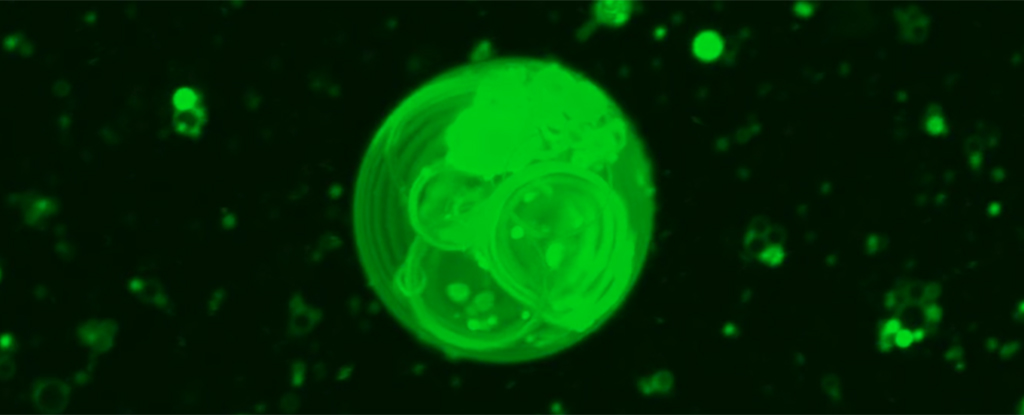The fossil record and genetic evidence suggest that prokaryotic cells were the first organisms on Earth. These cells originated approximately 3.5 billion years ago, which was about 1 billion years after Earth’s formation, and were the only life forms on the planet until eukaryotic cells emerged approximately 2.1 billion years ago. During the prokaryotic reign, photosynthetic prokaryotes evolved that were capable of applying the energy from sunlight to synthesize organic materials (like carbohydrates) from carbon dioxide and an electron source (such as hydrogen, hydrogen sulfide, or water).
Photosynthesis using water as an electron donor consumes carbon dioxide and releases molecular oxygen (O2) as a byproduct. The functioning of photosynthetic bacteria over millions of years progressively saturated Earth’s water with oxygen and then oxygenated the atmosphere, which previously contained much greater concentrations of carbon dioxide and much lower concentrations of oxygen. Older anaerobic prokaryotes of the era could not function in their new, aerobic environment. Some species perished, while others survived in the remaining anaerobic environments left on Earth. Still other early prokaryotes evolved mechanisms, such as aerobic respiration, to exploit the oxygenated atmosphere by using oxygen to store energy contained within organic molecules. Aerobic respiration is a more efficient way of obtaining energy from organic molecules, which contributed to the success of these species (as evidenced by the number and diversity of aerobic organisms living on Earth today). The evolution of aerobic prokaryotes was an important step toward the evolution of the first eukaryote, but several other distinguishing features had to evolve as well.
Endosymbiosis
The origin of eukaryotic cells was largely a mystery until a revolutionary hypothesis was comprehensively examined in the 1960s by Lynn Margulis. The endosymbiotic theory states that eukaryotes are a product of one prokaryotic cell engulfing another, one living within another, and evolving together over time until the separate cells were no longer recognizable as such. This once-revolutionary hypothesis had immediate persuasiveness and is now widely accepted, with work progressing on uncovering the steps involved in this evolutionary process as well as the key players. It has become clear that many nuclear eukaryotic genes and the molecular machinery responsible for replicating and expressing those genes appear closely related to the Archaea. On the other hand, the metabolic organelles and the genes responsible for many energy-harvesting processes had their origins in bacteria. Much remains to be clarified about how this relationship occurred; this continues to be an exciting field of discovery in biology. Several endosymbiotic events likely contributed to the origin of the eukaryotic cell.
Mitochondria
Eukaryotic cells may contain anywhere from one to several thousand mitochondria, depending on the cell’s level of energy consumption. Each mitochondrion measures 1 to 10 micrometers in length and exists in the cell as a moving, fusing, and dividing oblong spheroid (Figure 3.4.13.4.1). However, mitochondria cannot survive outside the cell. As the atmosphere was oxygenated by photosynthesis, and as successful aerobic prokaryotes evolved, evidence suggests that an ancestral cell engulfed and kept alive a free-living, aerobic prokaryote. This gave the host cell the ability to use oxygen to release energy stored in nutrients. Several lines of evidence support that mitochondria are derived from this endosymbiotic event. Mitochondria are shaped like a specific group of bacteria and are surrounded by two membranes, which would result when one membrane-bound organism was engulfed by another membrane-bound organism. The mitochondrial inner membrane involves substantial infoldings or cristae that resemble the textured outer surface of certain bacteria.
more...https://bio.libretexts.org/Courses/Cosumnes_River_College/Contemporary_Biology_(Aptekar)/03%3A_Cell_Structure_and_Function/3.04%3A_Eukaryotic_Origins#:~:text=The%20first%20eukaryotes%20evolved%20from%20ancestral%20prokaryotes%20by,cytoskeleton%2C%20and%20the%20acquisition%20and%20evolution%20of%20organelles.
and
We May Finally Know How The First Cells on Earth Formed
NATURE04 March 2024
By
DAVID NIELD





